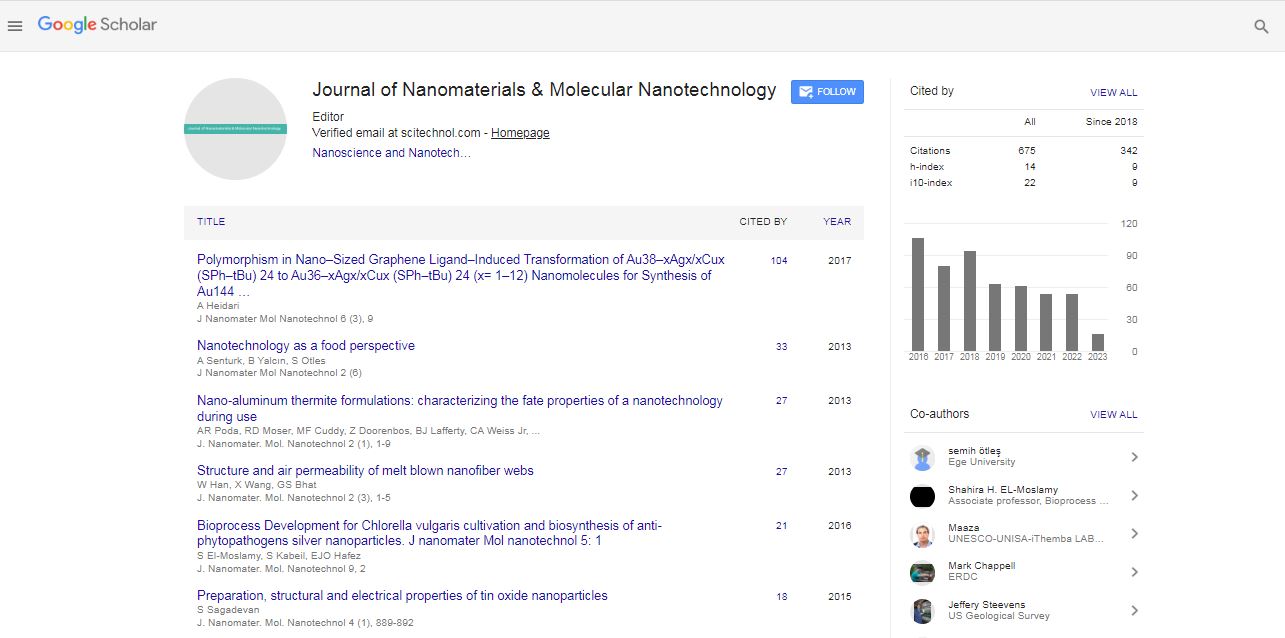Research Article, J Nanomater Mol Nanotechnol Vol: 3 Issue: 2
Rapid Induced Aggregation of Gold Nanoparticles by Diolefinic Dyes
| Ahmed A Abo-Alhasan1, Samy A El-Daly1,2, Morad M El-Hendawy3,5, Shahar H El-Khalfy1 and El-Zeiny M Ebeid1,4* |
| 1Chemistry Department, Faculty of Science, Tanta University, Tanta, Egypt |
| 2Chemistry Department, Faculty of Science, King Abdulaziz University, P.O. Box 80203, Jeddah 21589, Saudi Arabia |
| 3Chemistry Department, Faculty of Science, Kafrelsheikh University, Kafrelsheikh, Egypt |
| 4Misr University for Science and Technology (MUST), 6th of October City, Egypt |
| 5Higher Institute for Engineering and Technology, Kafrelsheikh, Egypt |
| Corresponding author : Dr. El-Zeiny M. Ebeid Chemistry Department, Faculty of Science, Tanta University, Tanta, Egypt Tel: +2-0403318302; E-mail: drzeiny@yahoo.com |
| Received: January 22, 2013 Accepted: March 11, 2014 Published: March 15, 2014 |
| Citation: Abo-Alhasan AA, El-Daly SA, El-Hendawy MM, El-Khalfy SH, Ebeid EM (2014) Rapid Induced Aggregation of Gold Nanoparticles by Diolefinic Dyes. J Nanomater Mol Nanotechnol 3:2. doi:10.4172/2324-8777.1000142 |
Abstract
Rapid Induced Aggregation of Gold Nanoparticles by Diolefinic Dyes
Aggregation kinetics of gold nanoparticles (Au NPs) interaction in the presence of some diolefinic dyes, namely 1,4-bis (β-pyridyl-2-vinyl) benzene (P2VB), 1,4 bis(2-methylstyryl) benzene (MSB) and 2,5 distyrylpyrazine (DSP), were studied in methanol using steady state UV-Vis spectrophotometry and stopped-flow spectrophotometry. All three dyes induced the aggregation of Au NPs, but with different rates. The rate of interaction of P2VB and MSB with Au NPs were in time-scale of milliseconds, 6 ms-1 and 3.25 ms-1, respectively, while the interaction between DSP and Au NPs occurred in time-scale of minutes. The rates of interaction between Au NPs and these dyes go in the order of P2VB > MSB » DSP. The density functional theory (CAM-B3LYP) predicted that the dye with higher group charge on the terminal moieties possess higher affinity toward the aggregation as it strengthen its electrostatic interactions with the citrate-capped Au NPs.




